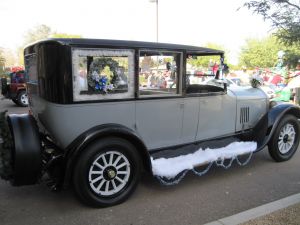- Home
- About Us
- Join/Renew
- Member Benefits
- Member Pages
- Log In
- Help
- Museum Store
I live in AZ and do not use my 1922 EDL in the hot summer months. Cooler weather is here, so I am getting ready for our driving season. PROBLEM: I changed the oil just like many times before, but now there is NO oil pressure.
Is there some way to prime the pump? Is the pump even accessible from the bottom. Thanks for your help.

Hello Stan.
I just looked at a Series 33 owners manual, and it shows the oil pump in the bottom of the oil pan. So unless the oil screen is clogged with sludge, the oil in the oil pan will fill the oil pump by gravity.
So: a few questions:
When you change the oil, do you remove the screen from the oil pan, and clean it in solvent?
If not, that would be the first step towards diagnosing the lack of oil pressure.
Have you ever removed the oil pump from the bottom of the oil pan, and inspected the pump’s gears and
pump body for scores, old damage or corrosion from water ??
The oil pump in the bottom of an oil pan is a great way to make it easily available for inspection and replacement, but it also creates a problem for engines that run cold, only short time periods, or sit for a long time.. This problem is that any of the three mentioned conditions: cold, short duration running, and long storage duration, will create or allow the collection of condensation on the inside of the engine. This water condensation will drop into the oil pan, and the water will gravitate to the bottom of the oil pan and to the pan’s lowest spot: Which is the oil pump.
The water, which is usually acidic in an engine, will displace the oil in the pump, and corrode the gears and the pump body.
So unless the engine has been rebuilt or the pump removed and inspected since you have owned the car, it probably should be done.. If it were my car, I’d inspect it just for peace of mind.
Hope this helps.
Greg Long
Great points, Greg. This is why the owners manuals and the restoration books always recommend that you change the oil the last time it is hot before a long winter nap. That way all the contaminants are removed with the oil, and fresh oil is left in the crankcase and in the bearing journals. For boats, the outdrive fluid is changed for the same reasons Greg outlined above. If you want proof, just cut open a spin on type oil filter after a car has sat for a few years, or pour out the “fuel” after changing a fuel filter on a boat after a hundred hours of occasional use. It will make you sick. I like to use a magnetized drain plug, or leave a magnet in the bottom of the oil pan to make sure the filings don’t get sucked back up into the oil screen. Kind of like Jak’s water filter in a previous discussion. That was brilliant!
If the oil pan screen is cleaned with solvent, take particular care to make sure that all of the solvent is out of the unit. A very small amount of solvent can destroy lubrication. I prefer to use gasoline to clean the unit. Gasoline will not destroy lubrication.
Good point Paul.
I used the term ‘solvent’ because many people will have carb cleaner or Brake cleaner in aerosol cans in their shop supplies. Both of those spray solvents should evaporate before you could get the screen reinstalled, but why risk it? Wave the screen around in that dry Arizona air for about 30 seconds and the solvent will be gone.
Paul: on this subject, is mineral spirits in small quantities going to reduce the lubrication quality in motor oil? I’m thinking of say a teaspoon or table spoon in a quart of motor oil?? Mineral spirits is what ‘Safety-Kleen’ used to be, and maybe still is. It’s what I use in my parts cleaning tank.
Thanks,
Greg Long
The generic name mineral spirits can cover a number of mixtures. My advice would be to stick with gasoline. Why take a chance on creating a lubrication problem.
